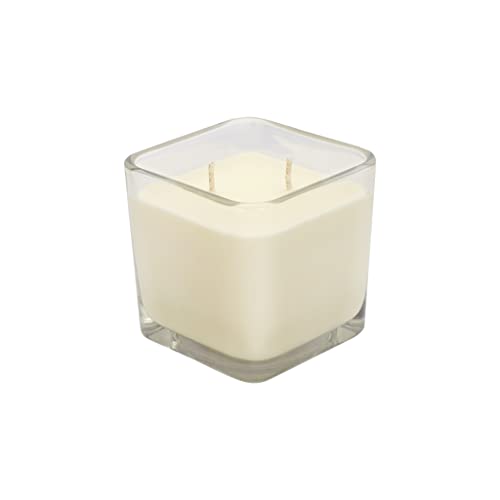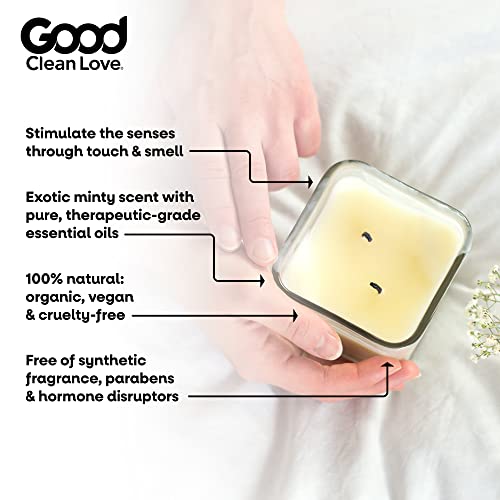

Good Clean Love Cocoa Mint Massage Candle - Natural Aphrodisiac, Vegan & Cruelty-Free - 12oz


Tocopherol, D Alpha
Low RiskTocopherol, specifically d-alpha tocopherol, is a naturally occurring form of Vitamin E. It is commonly used in cosmetic and personal care products primarily for its antioxidant properties, helping to protect formulations from oxidation and extend shelf life.
Sustai Insights
D-alpha tocopherol provides effective antioxidant benefits, contributing to product stability. It is sustainably sourced and generally regarded as safe, with low concerns regarding carcinogenicity, allergies, and reproductive toxicity. However, there are minor concerns about endocrine disruption. Regulatory bodies have not imposed significant restrictions, indicating low overall risk. Recommended usage practices include adhering to established safe concentration thresholds. Alternatives, such as other forms of Vitamin E or plant-based antioxidants, may also be considered.
Prunus Armeniaca (Apricot) Oil
Low RiskPrunus armeniaca (apricot) oil is a cosmetic ingredient derived from the seeds of the apricot fruit. It functions primarily as a moisturizer and emollient in cosmetic formulations, providing hydration to the skin while enhancing the texture and feel of products.
Sustai Insights
Prunus armeniaca oil offers functional benefits as a moisturizer and emollient, supporting skin hydration and texture. It is sustainably sourced with low environmental impact. Health risks are minimal, as it has low concerns for carcinogenicity, allergies, and reproductive toxicity. Regulatory bodies do not impose restrictions on its use. Overall, the ingredient is assessed to have low risk, making it a safe choice in cosmetic formulations. Alternatives include other plant oils that offer similar moisturizing properties.
Cocos Nucifera (Coconut) Oil
Low RiskCocos Nucifera (Coconut) Oil is derived from the kernels of the coconut palm. It is primarily used in cosmetic formulations for its emollient and moisturizing properties, making it suitable for skin and hair care products.
Sustai Insights
Coconut oil serves as an effective moisturizer and emollient, promoting skin hydration and softness. It is sustainably sourced and biodegradable. Health risks are minimal, with low concerns regarding carcinogenicity, allergens, and reproductive toxicity. Environmental impact is also low, as it does not contribute significantly to pollution or bioaccumulation. Regulatory bodies have not issued restrictions on its use. Overall, coconut oil presents a low risk for health and environmental concerns, making it a safe ingredient in cosmetic products.
Glycine Soja (Soybean) Oil
Low RiskGlycine soja (soybean) oil is derived from the seeds of the soybean plant and is commonly used in cosmetic formulations for its emollient properties. It functions as a moisturizer and skin conditioning agent, enhancing the texture and feel of products.
Sustai Insights
Glycine soja (soybean) oil offers functional benefits such as effective skin moisturization and conditioning. It is generally recognized as low-risk for health concerns, with minimal allergenic potential and no significant environmental hazards reported. Regulatory bodies have not imposed restrictions on its use. Overall, this ingredient is assessed as low risk, making it a suitable option for various cosmetic applications.
Simmondsia Chinensis (Jojoba)
Low RiskSimmondsia chinensis, commonly known as jojoba, is an oil derived from the seeds of the jojoba plant. It is commonly used in cosmetic formulations for its moisturizing properties, acting as an emollient and skin conditioning agent.
Sustai Insights
Jojoba oil offers functional benefits such as effective skin moisturization and is biodegradable, with sustainable sourcing practices. Health risks are low, with minimal concerns regarding carcinogenicity, allergies, and reproductive toxicity. Environmental impact is negligible, with no pollutant or bioaccumulation potential. Regulatory status is favorable with no significant restrictions noted. Overall, it is assessed as low risk, and safe usage practices should be maintained. Alternatives include other plant-derived oils like argan or almond oil, which may provide similar benefits.
Tocopherol, D Alpha
Low RiskTocopherol, specifically d-alpha tocopherol, is a naturally occurring form of Vitamin E. It is commonly used in cosmetic and personal care products primarily for its antioxidant properties, helping to protect formulations from oxidation and extend shelf life.
Sustai Insights
D-alpha tocopherol provides effective antioxidant benefits, contributing to product stability. It is sustainably sourced and generally regarded as safe, with low concerns regarding carcinogenicity, allergies, and reproductive toxicity. However, there are minor concerns about endocrine disruption. Regulatory bodies have not imposed significant restrictions, indicating low overall risk. Recommended usage practices include adhering to established safe concentration thresholds. Alternatives, such as other forms of Vitamin E or plant-based antioxidants, may also be considered.
Prunus Armeniaca (Apricot) Oil
Low RiskPrunus armeniaca (apricot) oil is a cosmetic ingredient derived from the seeds of the apricot fruit. It functions primarily as a moisturizer and emollient in cosmetic formulations, providing hydration to the skin while enhancing the texture and feel of products.
Sustai Insights
Prunus armeniaca oil offers functional benefits as a moisturizer and emollient, supporting skin hydration and texture. It is sustainably sourced with low environmental impact. Health risks are minimal, as it has low concerns for carcinogenicity, allergies, and reproductive toxicity. Regulatory bodies do not impose restrictions on its use. Overall, the ingredient is assessed to have low risk, making it a safe choice in cosmetic formulations. Alternatives include other plant oils that offer similar moisturizing properties.
Cocos Nucifera (Coconut) Oil
Low RiskCocos Nucifera (Coconut) Oil is derived from the kernels of the coconut palm. It is primarily used in cosmetic formulations for its emollient and moisturizing properties, making it suitable for skin and hair care products.
Sustai Insights
Coconut oil serves as an effective moisturizer and emollient, promoting skin hydration and softness. It is sustainably sourced and biodegradable. Health risks are minimal, with low concerns regarding carcinogenicity, allergens, and reproductive toxicity. Environmental impact is also low, as it does not contribute significantly to pollution or bioaccumulation. Regulatory bodies have not issued restrictions on its use. Overall, coconut oil presents a low risk for health and environmental concerns, making it a safe ingredient in cosmetic products.
Glycine Soja (Soybean) Oil
Low RiskGlycine soja (soybean) oil is derived from the seeds of the soybean plant and is commonly used in cosmetic formulations for its emollient properties. It functions as a moisturizer and skin conditioning agent, enhancing the texture and feel of products.
Sustai Insights
Glycine soja (soybean) oil offers functional benefits such as effective skin moisturization and conditioning. It is generally recognized as low-risk for health concerns, with minimal allergenic potential and no significant environmental hazards reported. Regulatory bodies have not imposed restrictions on its use. Overall, this ingredient is assessed as low risk, making it a suitable option for various cosmetic applications.
Simmondsia Chinensis (Jojoba)
Low RiskSimmondsia chinensis, commonly known as jojoba, is an oil derived from the seeds of the jojoba plant. It is commonly used in cosmetic formulations for its moisturizing properties, acting as an emollient and skin conditioning agent.
Sustai Insights
Jojoba oil offers functional benefits such as effective skin moisturization and is biodegradable, with sustainable sourcing practices. Health risks are low, with minimal concerns regarding carcinogenicity, allergies, and reproductive toxicity. Environmental impact is negligible, with no pollutant or bioaccumulation potential. Regulatory status is favorable with no significant restrictions noted. Overall, it is assessed as low risk, and safe usage practices should be maintained. Alternatives include other plant-derived oils like argan or almond oil, which may provide similar benefits.
Experience the intimate allure of the Good Clean Love Cocoa Mint Massage Candle. This handcrafted candle transforms into a warm, aromatic massage oil, enhancing moments of connection and pleasure. Designed with health and the environment in mind, it boasts an array of benefits perfect for the eco-conscious consumer.
- Natural Aphrodisiac: Melts into a sensuous oil within 30 minutes, creating an inviting atmosphere for relaxation and intimacy.
- Exotic Fragrances: A delightful blend of cardamom, peppermint, and amber creates a minty aroma that enhances both scent and touch.
- All-Natural Ingredients: Made from cruelty-free, vegan ingredients with no chemical additives or artificial fragrances, ensuring a pure experience.
- Eco-Friendly: Features a clean-burning, 100% cotton wick and low melting temperatures for safe, sustainable use.
- Easy to Use: Simply light the candle, pour the oil after testing the temperature, and enjoy a soothing massage while inhaling its captivating scent.
Indulge in this luxurious experience while supporting ethical practices and sustainable living.
Subscribe & Save with Sustai
- Best Price Guarantee: Always enjoy the lowest prices on sustainable home essentials.
- No Surprises: We’ll notify you before shipping. No hidden fees, ever.
- You’re in Charge: Change, pause, or cancel your subscription anytime with ease.
- Eco-Friendly Deliveries: Our grouped shipments mean less packaging and lower emissions.
Join us on a sustainable journey. Special offers for a limited time! Prices and promotions may change.
Recommended Products
Experience the intimate allure of the Good Clean Love Cocoa Mint Massage Candle. This handcrafted candle transforms into a warm, aromatic massage oil, enhancing moments of connection and pleasure. Designed with health and the environment in mind, it boasts an array of benefits perfect for the eco-conscious consumer.
- Natural Aphrodisiac: Melts into a sensuous oil within 30 minutes, creating an inviting atmosphere for relaxation and intimacy.
- Exotic Fragrances: A delightful blend of cardamom, peppermint, and amber creates a minty aroma that enhances both scent and touch.
- All-Natural Ingredients: Made from cruelty-free, vegan ingredients with no chemical additives or artificial fragrances, ensuring a pure experience.
- Eco-Friendly: Features a clean-burning, 100% cotton wick and low melting temperatures for safe, sustainable use.
- Easy to Use: Simply light the candle, pour the oil after testing the temperature, and enjoy a soothing massage while inhaling its captivating scent.
Indulge in this luxurious experience while supporting ethical practices and sustainable living.

You can have at most 2 Sustainable Steals products in your cart
Customer Reviews
Customers’ View
Customers appreciate the natural and eco-friendly qualities of the Good Clean Love Cocoa Mint Massage Candle. Many users highlight the sensuous experience it provides, noting how the candle melts into a warm oil that enhances intimacy and relaxation. The blend of essential oils, particularly the exotic aroma of cardamom and peppermint, is often praised for creating a soothing atmosphere. Additionally, the product's commitment to using vegan and cruelty-free ingredients resonates well with environmentally and health-conscious consumers. Overall, customers find this candle to be an enjoyable addition to their self-care routines, aligning with their values of sustainability and well-being.
AI-generated from the text of customer reviewsThis product has no reviews yet.




